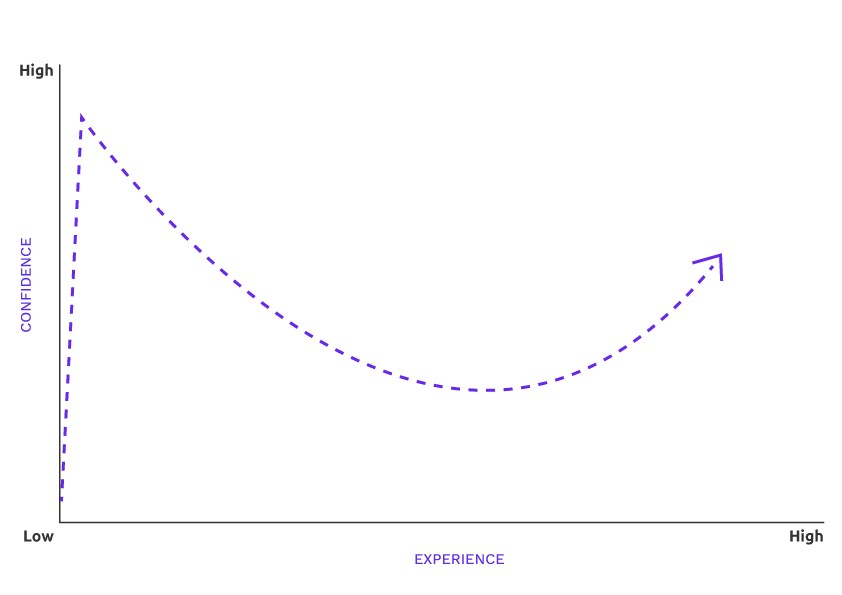A Design Sprint team is greater than the sum of its parts.
Stop the imposter
Before we unpack this statement, I want to address the imposter syndrome phenomenon. Offering a spot of creative community encouragement. If you don’t know, the imposter syndrome is:
A psychological pattern in which an individual doubts their accomplishments and has a persistent internalised fear of being exposed as a fraud.
Most people, if not all of us, have experienced this feeling to varying degrees throughout our careers. Our peer group, whether work or community based, shape how we feel about ourselves. Sure, there are some really, really clever people out there, but make sure you can attribute their smarts to the ‘fruit’ they produce and not mere bravado alone.
Dunning-Kruger effect
The Dunning-Kruger Effect is a tendency for unskilled people to overestimate their competence and performance. Basically, incompetent people lack the knowledge and experience to recognise their own incompetence, as well as the competence of others. Conversely, highly competent people tend to underestimate their abilities and performance, and overestimate the skills of others. Sound familiar?
 The least competent tend to be the most confident, and then the roller coaster ride of reality begins.
The least competent tend to be the most confident, and then the roller coaster ride of reality begins.
Wherever you are on this graph, if you are into Design Sprints and/or workshop facilitation then you’ve experienced the amazing results you can achieve from the collective power of people. Remind yourself that nobody knows everything. Would you rather work with 5 smart people or just 1 genius? The systematic harnessing of the hive mind that makes up any Sprint team or Design Thinking workshop beats any effort of a genius or self-proclaimed expert.
Meetings out, workshops in
Our prediction is that over the next few years we are going to see a massive shift in working collaborative culture. Those who adapt will thrive and succeed. Those who are reluctant and inflexible will be left behind. Workshops and actionable gatherings will be the new norm. Round table meetings, catch-ups, and busy work will be seen as archaic. We are already seeing this shift now in the companies we work in, and from conversations we’re having with others in our profession.
The alternative to Design Sprints
For us to understand how important Design Sprints are in tackling the likes of imposter syndrome and the Dunning-Kruger effect, we first need to look at what the alternative and traditional methods are. We’ve all been in those round-table meetings with the endless unstructured conversations. Each person practising their one-upmanship, the loudest person gets the most airtime, and the quiet ones slip into their chairs. Typically these meetings then end with little to no actions and not everyone has had a say. It can be frustrating for those who have experienced another way; the Design Sprint.
When first pitching Design Sprints to management, stakeholders, and leadership it can sound daunting. A week of people’s time! But let’s take a minute to break down what we may do instead. Imagine we have an idea or a problem and want to test it with customers using traditional methods. If this team is 7 people strong and we spend a month doing some research and analysis, another month designing, and 3 months building. We still need to test this idea or problem with customers, let’s allow another month for that. Now, these estimates are just an example but in total, we arrive at 6 months before we’ve learned from our customers. That’s 6 months of 7 people’s time before we know anything! Does a week sound so drastic anymore?
“We don’t have time to spend a week doing a sprint”. We hear this often. Your response should be that we don’t have time to not be doing a sprint. We need to learn quickly from our customers so we can adapt and truly be agile. The days of spending 6 months before learning are hopefully numbered; tackled one sprint at a time.
Everyone gets a voice
Casting back to our meeting scenario where some people don’t get a voice. It’s easy to see how a sprint combats this. Each individual gets the chance to express their ideas and have them evaluated anonymously. This anonymous critique takes away any bias towards an individual (some people may see a designer’s solution more favourably) and the anonymity also lets people feel more comfortable about sharing their ideas. Design Sprints also control those who underestimate or overestimate their ability. There’s very little chance for someone to talk up their idea. People of varying confidence levels also have an equal footing during a sprint, which is not what can be said for those long round-table meetings. The collective power that a team of individuals can attain whilst working holistically around any problem is 10 times greater than any single expert can achieve. Collaboration is the future and workshop facilitators hold the key.
Running a Design Sprint?
Download our free slide deck. It includes tips for every exercise on each sprint day.
